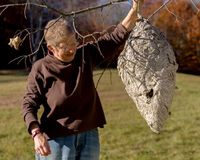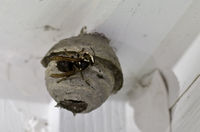Dolichovespula: Difference between revisions
No edit summary |
|||
| Line 7: | Line 7: | ||
thumb]] | thumb]] | ||
Kingdom: ''Animalia'' | {| class="wikitable" style="text-align:center; float:left; margin-left: 10px; | ||
|+ !colspan="2" style="min-width:12em; text-align: center; background-color: rgb(235,235,210)|'''Scientific Classification''' | |||
Phylum: [http://soil.geology.buffalo.edu/index.php/Insects ''Arthropoda''] | |- | ||
!style="min-width:6em; |Kingdom: | |||
Class: '' Insecta'' | |style="min-width:6em; |''Animalia'' | ||
|- | |||
Order: ''[[Hymenoptera]]'' | !style="min-width:6em; |Phylum: | ||
|style="min-width:6em; |[http://soil.geology.buffalo.edu/index.php/Insects ''Arthropoda''] | |||
Family: ''Vespidae'' | |- | ||
!style="min-width:6em; |Class: | |||
Genus: ''Dolichovespula'' | |style="min-width:6em; |''Insecta'' | ||
|- | |||
!style="min-width:6em; |Order: | |||
|style="min-width:6em; |''[[Hymenoptera]]'' | |||
|- | |||
!style="min-width:6em; |Family: | |||
|style="min-width:6em; |''Vespidae'' | |||
|- | |||
!style="min-width:6em; |Genus: | |||
|style="min-width:6em; |''Dolichovespula'' | |||
=='''Overview'''== | =='''Overview'''== | ||
Revision as of 21:07, 6 March 2025
Classification

| Kingdom: | Animalia | |||
|---|---|---|---|---|
| Phylum: | Arthropoda | |||
| Class: | Insecta | |||
| Order: | Hymenoptera | |||
| Family: | Vespidae | |||
| Genus: | Dolichovespula
Overview![Fig 2. Distribution of Dolichovespula maculate across North America. [2] thumb](/images/thumb/4/43/Map.png/150px-Map.png) | thumb
Dolichovespla are a genus of social wasps, in the family Vespidae. Its common names include the yellow jacket, bald-faced hornet, white-faced hornet, bald hornet, black jacket, and bull wasp. They can be found in most of the lower 48 states and throughout Canada and Alaska. Habitats vary between species, but they can be found mostly in forested areas or in vegetation in urban areas. Nests are generally located in trees and bushes, but can occasionally be found under rock overhangs and on the sides of buildings. There are 24 recognized species of Dolichovespla[10][11][12]:
Dolichovespula maculataDolichovespula maculata, or bald-faced hornets, get their name from the white markings on the face, legs, thorax, and abdomen. Aside from these markings, the body is dark black. They have brown wings and brown eyes. They are the largest species in the Dolichovespula genus. Workers can grow to be up to 12-14 mm long, while the queen is 18-20 mm long.[13] Behavior and Colonization Defense MechanismsDolichovespula maculata, or bald-faced hornets, defend their nests aggressively against all threats. Specifically, they can shoot venom from the stinger directly into the eyes of the threat. This venom causes temporary blindness or watering of the eyes. The sting itself can be painful, itchy or burning as well as causing swelling at the site of the sting. [4] While these hornets can be helpful in pest control for humans, some humans are allergic to the venom, and with nests in close proximity to human development, it can be accidental that humans are perceived as a threat. When this happens, different methods of control are applied that mainly involve treating the nest. [4] Importance In Soil References[1] Jacobs, Steve. “Baldfaced Hornet (Department of Entomology).” Department of Entomology (Penn State University), 2015, ento.psu.edu/extension/factsheets/baldfaced-hornet. https://ento.psu.edu/extension/factsheets/baldfaced-hornet [2] “Dolichovespula Maculata, Distribution.” Dolichovespula Maculata, Distribution Image, www.discoverlife.org/mp/20p?see=I_SD4398&res=640. https://www.discoverlife.org/mp/20p?see=I_SD4398&res=640 [3] Heinrich, B. J. J. o. C. P. B. 1984. Strategies of thermoregulation and foraging in two vespid wasps, Dolichovespula maculata andVespula vulgaris. 154:175-180. https://link.springer.com/article/10.1007/BF00684142 [4] Oswalt, Donald A, and Patricia A Zungoli. “Baldfaced Hornets.” Home & Garden Information Center | Clemson University, South Carolina, hgic.clemson.edu/factsheet/baldfaced-hornets/. https://hgic.clemson.edu/factsheet/baldfaced-hornets/ [5] Gambino, P. J. J. o. t. N. Y. E. S. 1995. Dolichovespula (Hymenoptera: Vespidae), hosts of Aphomia sociella (L.)(Lepidoptera: Pyralidae).165-169. https://www.jstor.org/stable/25010152?seq=1#page_scan_tab_contents [6] “Dolichovespula Maculata.” Bio 210 Vespula Maculata, bioweb.uwlax.edu/bio210/s2012/bollinge_seth/nutrition.htm. http://bioweb.uwlax.edu/bio210/s2012/bollinge_seth/nutrition.htm [7] “Georgia Department of Agriculture.” Baldfaced Hornets - Ga Dept of Agriculture, agr.georgia.gov/baldfaced-hornets.aspx. http://agr.georgia.gov/baldfaced-hornets.aspx [8] Holland, Mary. “Bald-Faced Hornet Nests No Longer Inhabited (If You Live Where There Has Been a Hard Frost).” Naturally Curious with Mary Holland, 3 Nov. 2015, naturallycuriouswithmaryholland.wordpress.com/2015/11/03/bald-faced-hornet-nests-no-longer-inhabited-if-you-live-where-there-has-been-a-hard-frost/. https://naturallycuriouswithmaryholland.wordpress.com/2015/11/03/bald-faced-hornet-nests-no-longer-inhabited-if-you-live-where-there-has-been-a-hard-frost/ [9] “Bald-Faced Hornet, Queen - Dolichovespula Maculata - a Photo on Flickriver.” Flickriver, www.flickriver.com/photos/maximillian_millipede/3558361392/. https://www.flickriver.com/photos/maximillian_millipede/3558361392/ [10] ADW: Dolichovespula: CLASSIFICATION. (n.d.). . https://animaldiversity.org/accounts/Dolichovespula/classification/. [11] Dolichovespula. (n.d.). . http://www.nic.funet.fi/pub/sci/bio/life/insecta/hymenoptera/apocrita/vespidae/dolichovespula/index.html. [12] Kimsey, L., and J. Carpenter. 2012. The Vespinae of North America (Vespidae, Hymenoptera). Journal of Hymenoptera Research 28:37–65. [13] Hauze, D. (n.d.). Dolichovespula maculata. https://animaldiversity.org/accounts/Dolichovespula_maculata/. |